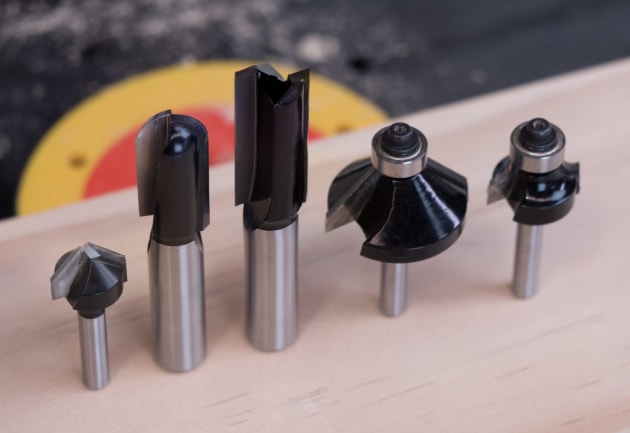Your guide to router bits
If you’re new and even not-so-new to the world of woodworking there is much to know. Here’s a basic guide to the basic router bits you may use while you work.
The Router. A router is essentially a power tool that is used to rout or hollow out an area in relatively hard materials like wood or plastic. Typically handheld the router may also be installed cutting-end up in a router table.
Bearing Guides. These are a machine component, handy for following irregular shaped templates or ensuring a straight edge is followed precisely.

Straight Bits. Used for general-purpose routing, including grooving, trenching, rebating, mortising or milling materials to a required thickness. They cut ‘straight’ into the material and are available in a variety of lengths and diameters.

Flush Trim Bits. These are for trimming a veneer or laminate flush with the substrate, or creating a template or pattern. They are used for fast, smooth and accurate edge trimming as bearing guides are the same diameter as the cutter so they cut ‘flush’. The bearings can also be mounted on the shank end, cutter end or both, and they come in straight flute, down-shear angle, and upcut and downcut solid carbide spiral flutes. If you’re working with soft materials, a double bearing series is also available to increase surface area contact to avoid any indentations in the material.

Chamfering Bits. Chamfering bits are used to remove sharp corners and create bevelled edges. While 45 degree chamfer bits are the most popular, they are also available as standard in 5, 10, 22.5, 30, 65 and 80 degrees from the vertical axis.

Rebating Bits. These bits will cut rebates on the edge of a material, such as the recess on the back of a picture frame in which the glass and artwork-mounting board are inserted. You can use the bearing to determine the depth of the rebate, which can be adjusted by changing the bearing size or using shielded bearings. The height of the rebate can be altered via height adjustment on the routing machine.

Edge Forming Bits. Decorative edges include round over, beads, coves, ogee, Roman ogee, classical, traditional classical, provincial and bullnose. Most edge forming bits have a pilot bearing which can be used as a guide to run either directly on a finished edge or on a fence or guide fixed to the workpiece.

Edge and Face Forming Bits. Edge and face forming bits have no bearing guide, enabling the shaped form to extend across the bottom of the cutter and cutting directly into the face of the material. If you haven’t got a steady hand, templates can be followed to guide the tool path. Alternately, they can be used for edge forming by using the routing machine guide or in a router table using a fence as a guide.
Specialised Bits. The range includes tongue and groove, finger joint, drawer joint, mitre lock, panel door, window sash and rail, dovetail bits.
Even more Specialised Bits. The list goes on with solid surface bits, face moulding bits (for skirting boards and architraves), raised panel bits, slotting cutters, combination bits, stair handrail bits, dishcut bits, hook slot bits, T-slot bits, edgeband trim bits, drawer pull bits.
Information provided by Carbitool, Australian manufacturers and suppliers of router bits and tooling.
Learn more at www.carbitool.com.au



